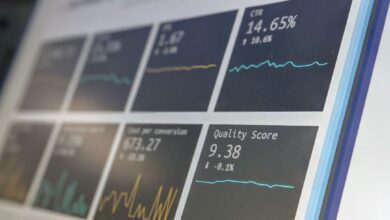High-Frequency Trading Explained: Harnessing Technology and Speed for Effective Trading Strategies

In the fast-paced world of financial markets, High-Frequency Trading (HFT) has emerged as a game-changing strategy that leverages cutting-edge technology to execute trades at lightning speed. As traditional trading methods evolve, understanding HFT becomes crucial for traders across various sectors, including stock trading, forex trading, and commodities trading. With its reliance on algorithmic trading, HFT enables traders to capitalize on minute price fluctuations, making it an attractive option for day trading and scalping strategies.
In this article, we'll delve into the intricacies of high-frequency trading, exploring the technology that powers rapid market moves and how it stands apart from traditional trading practices. We will examine the significant differences in strategy and execution between HFT and conventional methods, shedding light on the importance of market analysis and risk management. Furthermore, we will highlight the essential role of algorithmic trading in enhancing speed and efficiency, ultimately helping traders optimize their trading strategies. Whether you are engaged in options trading, futures trading, or even crypto trading, understanding HFT can provide you with valuable insights to navigate the ever-evolving landscape of online trading platforms. Join us as we unravel the complexities of high-frequency trading and its impact on the financial markets.
- 1. Understanding High-Frequency Trading: The Technology Behind Rapid Market Moves
- 2. High-Frequency Trading vs. Traditional Trading: Key Differences in Strategy and Execution
- 3. The Role of Algorithmic Trading in High-Frequency Trading: Enhancing Speed and Efficiency
1. Understanding High-Frequency Trading: The Technology Behind Rapid Market Moves
High-Frequency Trading (HFT) represents a significant evolution in the world of trading, utilizing advanced technology and sophisticated algorithms to execute thousands of trades in mere seconds. At its core, HFT relies on high-speed connections and powerful computers to analyze market data and execute trades at lightning speed. This technology enables traders to capitalize on minute price fluctuations that occur in various markets, including stock trading, forex trading, and commodities trading.
Understanding the mechanics of HFT involves delving into algorithmic trading, where traders develop complex algorithms that automatically identify trading opportunities based on predefined criteria. These algorithms can assess market conditions in real-time, employing technical analysis to make split-second decisions that human traders simply cannot match. For instance, in options trading and futures trading, HFT algorithms can scan for arbitrage opportunities across different exchanges, ensuring that traders can profit from price discrepancies.
The speed of HFT is not just a matter of rapid execution; it also involves sophisticated risk management techniques. Traders must be aware of the potential downsides of leverage trading and margin trading, as these can amplify both gains and losses. Therefore, effective risk management and trading strategies are crucial to maintain profitability and minimize exposure to market volatility.
In addition to technical analysis, successful HFT also considers trading psychology. The ability to remain calm during rapid market moves is essential for making informed decisions. Traders often utilize online trading platforms that offer features for copy trading and social trading, allowing them to leverage the insights and strategies of more experienced traders.
Furthermore, as the landscape of trading continues to evolve, HFT plays a significant role in day trading, swing trading, and even crypto trading. By employing high-speed trading techniques, traders can engage in scalping, taking advantage of small price changes throughout the day. This rapid pace of trading is also applicable to index trading and CFD trading, where traders can respond to market trends almost instantaneously.
Overall, the technology behind high-frequency trading not only transforms how traders execute trades but also reshapes market dynamics. With the right combination of technology, risk management, and market analysis, traders can effectively leverage HFT to navigate the complexities of modern trading environments, including energy trading and binary options. As the trading landscape continues to advance, understanding these technological underpinnings becomes increasingly essential for those looking to succeed in the fast-paced world of trading.
2. High-Frequency Trading vs. Traditional Trading: Key Differences in Strategy and Execution
High-Frequency Trading (HFT) and traditional trading represent two distinct approaches to the fast-paced world of financial markets. The key differences in strategy and execution lie primarily in the speed of transactions, the technology employed, and the trading strategies utilized.
One of the most significant contrasts is the execution speed. High-frequency trading relies on sophisticated algorithms and powerful computers to execute trades in fractions of a second. This ultra-fast execution allows HFT traders to capitalize on minute price discrepancies across various markets, employing strategies like arbitrage trading, where they simultaneously buy and sell securities to profit from price differences. In contrast, traditional trading methods, which may include day trading, swing trading, or even options trading, typically involve longer holding periods and rely on manual execution or slower algorithmic trading systems.
The technology used in HFT is also a defining factor. HFT firms invest heavily in cutting-edge technology, including high-speed data feeds and co-location services, which position their servers closer to the exchange’s infrastructure to reduce latency. Traditional trading, on the other hand, may utilize online trading platforms that cater to retail traders, which often lack the same level of speed and sophistication found in HFT operations.
In terms of trading strategies, high-frequency traders often focus on scalping, seeking to make small profits on numerous trades throughout the trading day. They employ technical analysis to identify patterns and trends that can be exploited in real time. Traditional traders, however, may utilize a wider range of strategies, including fundamental analysis to make longer-term investment decisions in stock trading, forex trading, or commodities trading.
Risk management also differs significantly between HFT and traditional trading. HFT traders often operate with tight risk management protocols due to the high volume of trades executed in a short period. They might use leverage trading or margin trading to amplify returns, but this also increases risk exposure. Traditional traders, particularly those engaged in day trading or swing trading, might adopt more diversified strategies with longer timeframes to mitigate risks associated with sudden market movements.
Finally, trading psychology plays a crucial role in both approaches. HFT traders must maintain a high level of discipline and emotional control, as the rapid nature of their trades leaves little room for error. On the other hand, traditional traders often face different psychological challenges, such as the stress of waiting for the right moment to enter or exit a trade.
In summary, the key differences between high-frequency trading and traditional trading are rooted in execution speed, technology, trading strategies, risk management approaches, and the psychological challenges faced by traders. Understanding these differences is essential for anyone looking to navigate the complex landscape of modern trading.
3. The Role of Algorithmic Trading in High-Frequency Trading: Enhancing Speed and Efficiency
Algorithmic trading plays a pivotal role in high-frequency trading (HFT), as it allows traders to execute orders at lightning speed and with remarkable precision. By leveraging sophisticated algorithms and technology, traders can capitalize on minute market fluctuations that occur within fractions of a second. This is particularly beneficial in various trading markets, including stock trading, forex trading, options trading, and futures trading, where timing is critical.
At its core, algorithmic trading involves using computer programs to automate the trading process. These algorithms are designed to analyze vast amounts of data, facilitating real-time market analysis that enhances the decision-making process. For example, in day trading and swing trading, traders can employ algorithms to identify patterns and trends through technical analysis, allowing them to execute trades based on predetermined criteria. This not only improves the speed of trading but also minimizes the emotional impact of trading psychology, as decisions are driven by data rather than human impulses.
Moreover, algorithmic trading can optimize various strategies across different asset classes, such as commodities trading, index trading, and even crypto trading. Traders can employ advanced strategies like scalping and arbitrage trading, which require rapid execution and constant market monitoring. By using algorithms, these traders can take advantage of price discrepancies across markets or exchanges, thus enhancing their profit potential.
Risk management is another significant aspect where algorithmic trading excels. Algorithms can be programmed to implement strict risk management rules, such as setting stop-loss orders or adjusting position sizes based on market volatility. This automated approach ensures that traders maintain control over their investments while engaging in margin trading, leverage trading, or CFD trading, reducing the likelihood of significant losses.
In summary, the integration of algorithmic trading in high-frequency trading not only boosts speed and efficiency but also refines trading strategies across various markets. By harnessing the power of technology, traders can navigate the complexities of modern trading landscapes—from energy trading to binary options—while maintaining a disciplined and analytical approach.
In conclusion, high-frequency trading (HFT) has transformed the landscape of trading by leveraging advanced technology and rapid execution to capitalize on market opportunities. As we've explored, the key differences between high-frequency trading and traditional trading methods highlight the strategic advantages offered by algorithmic trading, which enhances both speed and efficiency. This modern approach to stock trading, forex trading, options trading, and beyond allows traders to implement sophisticated trading strategies, such as scalping and arbitrage trading, while optimizing risk management through precise market analysis.
As the trading ecosystem evolves, so too do the tools and platforms available to traders, including online trading platforms that facilitate everything from day trading to commodities trading. The integration of HFT within various markets—from crypto trading to index trading—underscores its significance in today's fast-paced trading environment. Ultimately, a solid understanding of technical analysis, fundamental analysis, and trading psychology will empower traders to navigate the complexities of high-frequency trading effectively, whether they are engaging in margin trading, CFD trading, or exploring new avenues like energy trading and binary options.
Embracing the innovations of HFT can provide traders with a competitive edge, enabling them to execute trades with unmatched speed and precision. As we move forward, the continuous development of trading technologies will undoubtedly shape the future of trading strategies, making it essential for traders to stay informed and adaptable in this dynamic market landscape.





